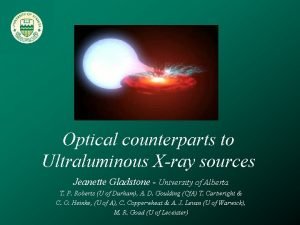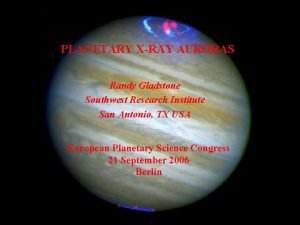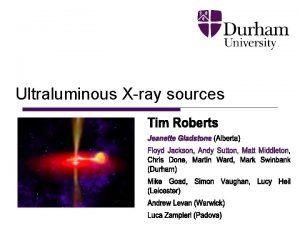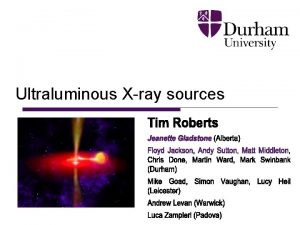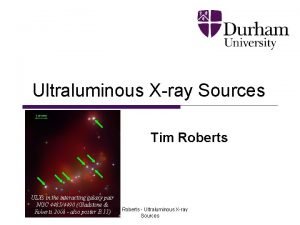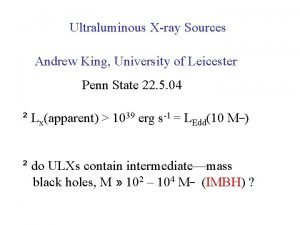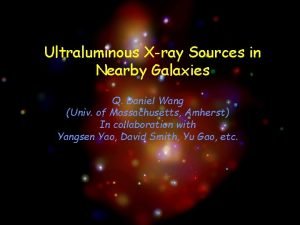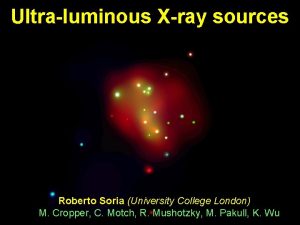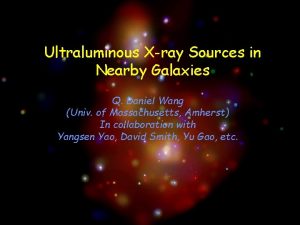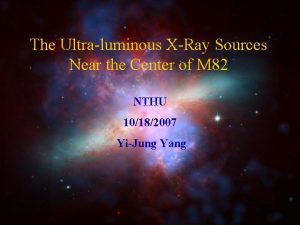Optical counterparts to Ultraluminous Xray sources Jeanette Gladstone















- Slides: 15

Optical counterparts to Ultraluminous X-ray sources Jeanette Gladstone - University of Alberta T. P. Roberts (U of Durham), A. D. Goulding (Cf. A) T. Cartwright & C. O. Heinke, (U of A), C. Copperwheat & A. J. Levan (U of Warwick), M. R. Goad (U of Leceister)

What are Ultraluminous X-ray sources? X-ray point source residing outside the nucleus of the galaxy We know they contain black holes but, what are their masses? Thought to be X-ray What option do we have to explain binaries, containing black hole their nature? LX > 1039 erg s-1 Why (above do we care? Eddington limit for 10 solar mass black hole) X-ray Universe 2011 composite X-ray (red)/optical (blue & white) image of the spiral galaxy M 74 (NASA/CXC/U. Michigan/J. Liu et al. ) Jeanette Gladstone University of Alberta

What are ULXs? Why do we care? Intermediate mass black holes Stellar mass black holes Missing link in the mass Contain objects we can After more than 30 years of study, we scale easily form areroute currently unable to settle thisextreme in Provide to form super Some of the most massive black accretors our universe the holes X-ray band … how inabout Provide insight into the Provides a need for new optical? formation of galaxies accretion physics Either way, we have something different and new to study X-ray Universe 2011 Jeanette Gladstone University of Alberta

Identification of optical counterparts Can use unprecedented spatial resolution of the Chandra telescope Allows for more accurate positioning of sources Also need help of HST X-ray Universe 2011 From Zampier et al 2004 showing 90% confidence radii for various X-ray instruments against and ESO 3. 6 m R-band image of NGC 1313 X-2 Jeanette Gladstone University of Alberta

New search for stellar counterparts Search restricted <5 Gladstone et al in prep Mpc Total of 45 ULXs 31 have both archival Chandra & HST data 23 have potential optical counterparts M 81 X-6 NGC 3034 ULX 6 X-ray Universe 2011 Jeanette Gladstone University of Alberta

Optical counterparts - one stage further NGC 1313 X-1 IC 342 X-1 X-ray Universe 2011 38 potential counterparts, some are multiple As data is archival, we have 1 -5 bands for each Magnitudes from available bands can be used to get first order estimate on stellar types Jeanette Gladstone University of Alberta

Stellar types? Reveals many are consistent with OB type stars (although some for X-ray irradiation Need to account appear later- M, K &effects, G type)due to high levels of X-ray emitted from these sources. Absolute magnitudes more indicative of giant stars X-ray Universe 2011 Jeanette Gladstone University of Alberta

Accounting for an accretion disc Apply irradiation models to binary systems containing a black hole and a companion star Black holes cover stellar and intermediate mass range 1000 M Covers a range of stellar masses and radii Multiple bands required so only able to apply to ~20 possible counterparts X-ray Universe 2011 Jeanette Gladstone University of Alberta

cos (i) = 0 Current data cannot provide us with enough information to differentiate We need multiple bands NGC 253 ULX 2 in the same epoch & deeper images to improve statistics cos (i) = 0. 5 Case 1: 8 < M* < 20 M , very large radius, MBH > 40 M Case 2: M* < 20 M , 8 < R* < 80 R , MBH – no constraint X-ray Universe 2011 Jeanette Gladstone University of Alberta

Another reason for constructing a catalogue … Secondary aim of this catalogue was to search for optical counterparts that are bright enough to allow for optical spectroscopic follow-up Highlighted several good sources for follow-up X-ray Universe 2011 Jeanette Gladstone University of Alberta

Pilot spectra of the ULX counterparts Gemini G-MOS spectra obtained Gemini-S NGC 1313 X-2, 3 hr Gemini-N NGC 5204 X-1, 0. 8 hr Ho IX X-1, 1. 5 hr X-ray Universe 2011 Jeanette Gladstone University of Alberta

Varying He II emission? X-ray Universe 2011 Jeanette Gladstone University of Alberta

Slight complication … A deeper look reveals extended He II emission Single He II line contains 2 components Currently don’t have the resolution to separate the two We can work with limits however … X-ray Universe 2011 Jeanette Gladstone Ho IX X-1 Moon et al 2011 University of Alberta

Constraining the mass? Ho IX X-1 2σ upper limits: K < 97 km s-1 X-ray Universe 2011 Jeanette Gladstone University of Alberta

What are ULXs? Cannot answer this as yet, do have lower limits need photometry at multiple wavebands (and spectra) to help classify counterpart Need greater signal-to-noise and/or resolution to start to statistically separate the He II components What about their companions? Confirmed 12 possible, identified 26 new potential candidates Many consistent with OB classification (although some later giants also identified) By accounting for X-ray irradiation, we are beginning to constrain their mass and radius X-ray Universe 2011 Jeanette Gladstone University of Alberta

